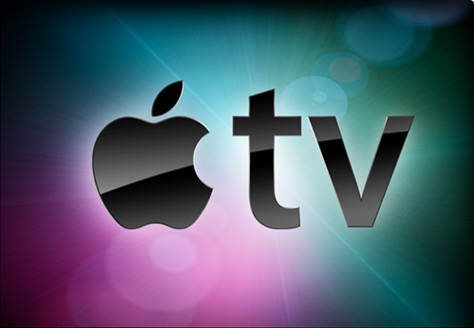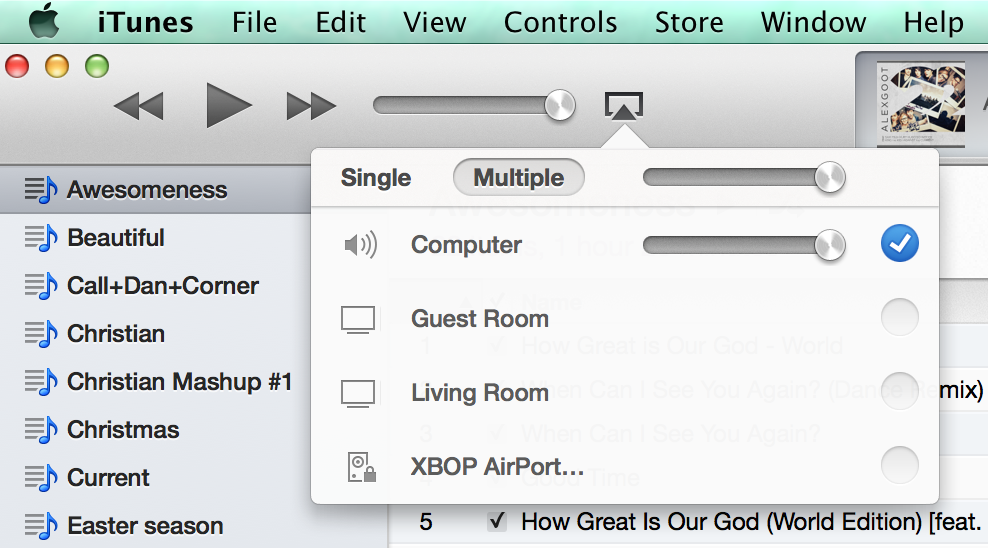In recent times not only has my church been given the multiple Apple TV treatment, but also I have expanded the number of Apple TVs present at home.
Apple TVs have been something of a phase of late. Not only have I expanded their use and availability at church, but now at home, we have two units set-up – with the latest unit being added to the other television unit and named (for now) Guest Room. The other, original unit is named for its location – Living Room. Now, you may think that there is nothing new with adding multiple Apple TVs into the one environment/wireless network, and you are correct.
The purpose of this article is to simply summarise some of the more confusing and complex features available to having multiple Apple TVs – not that the complexity is that extreme anyway.
For now, relying on the native-developed Apple capabilities, iTunes is the only software/app on a Mac/iMac where you can specific multiple audio outputs. In this regard, the home wireless network has three choices, as shown in the following screen-shot:
AirPort Express
The third option is the AirPort Express unit, which requires a little bit of explanation in the way it fits into the general environment. The AirPort Express was acquired sometime in 2013 (from memory?) to extend the wireless networking capabilities within the household.
Out of the box, the AirPort Express has as one of its capabilities a 3.5mm stereo connection, where you can attach speakers as an output device. Since the AirPort Express unit is located physically with our iMac and printer, to maximise flexibility, I used a splitter in the reverse – to allow for multiple audio inputs to the separate 2.1 Logitech speakers which are used primarily to support audio output from the iMac.
The Logitech speakers thus have the simple ability to receive audio signal from both the iMac OR the Airport Express. Now, this second network-driven input is redundant from an iMac perspective (given the direct cable solution), but as the screen-shot above indicates, it allows for me to pipe music/audio from any one of the other devices – Macbook, iPhones, or iPads – to those speakers.
The Airport Express also performs three additional functions:
- Acts as an Wi-Fi extender, receiving the Wireless network signal from the wireless access point Apple Time Capsule.
- Physical wired USB connection of the printer into the network
- Physical ethernet connection of the iMac (which has Wi-Fi turned off)
Whilst I explain the role of the AirPort Express, I should also explain the different connectivity options explored over time for my printer.
Printer (HP Photosmart B110 Series)
Over the years of having the HP Photosmart printer, it has always been physically located next to the iMac since the desk space has just enough room to accommodate it and a widescreen monitor/21-inch iMac. These physical constraints include bookshelves which are part of the accompanying cupboard/wardrobe unit, all now permanently built into the wall space. Indeed, the bookshelf height above the desk is a major constraint to preventing us from having the larger 25-inch iMac unit, the 21-inch unit fits snugly in place with a 4-5cm gap between. It is also the width/length constraints of both printer and iMac side-by-side that limit our options.
Over the years, the following connectivity options have been explored.
- Connected via USB cable direct to the iMac. This restricts accessibility solely to the iMac, or required sharing of the printer as a network printer, where the iMac must first be turned on.
- Connected via Wi-Fi to all devices. This expanded availability of the printer to all Apple devices – iPhones and iPads in addition to the computer MacBooks/iMacs via AirPrint, which is an in-built capability of the HP Photosmart printers.
- Connected via USB to the AirPort Express (Wi-Fi turned off), providing the same effect of (2) with the additional ability of the network printer to be detected on PCs sharing the same network. (PCs cannot access the printer using AirPrint)
AirPlay & Multiple Devices Features
So, returning to the original topic at hand – multiple Apple TVs. When they all share the same network, each Apple TV will appear as a selectable output device for AirPlay (audio and/or video). The ability to output to multiple devices simultaneously requires third-party apps/software – this feature has more merit and use in settings where you have an event where multiple video screens may be desirable. Even then, to avoid degradation of the signal over a wireless network, a wired solution using video signal splitters and boosters is probably the better solution.
As mentioned in the Video Infrastructure update of July 2014, consideration of multiple wireless networks to isolate each Apple TV was only an initial thought not pursued. The church environment also has two wireless networks available – and over time, a review may lead us to switching the Apple TVs over to the Office wireless network. One of the key considerations here is the fact that the AV wireless network is not a 24×7 permanently available network – it relies of the backstage rack/Cisco router being powered, since the wireless access point/Airport Extreme unit connects to the rack in order to have internet connectivity.
In the household network, my Dad and I have our own Apple ID/accounts. This reflects the fact that we each have our own iPhone, iPad and computer (Macbook for myself, iMac for my Dad). Technically, we each have our own Apple TV device, since, to date, I have used the original Apple TV in the Living Room 99% of the time, and I envisage the new Guest Room Apple TV will also be used by my Dad 99% of the time. Having said that, the one Apple TV device can have multiple Apple IDs stored on it for accessing our respective iTunes Libraries.
The Apple Remote app on the iPhone/iPad seems to work quite happily with both Apple TVs. The initial view of the Remote app lists all iTunes Libraries and Apple TV devices that share the use of the one Apple ID. Additional remote devices (iPhones / iPads) can be individually configured to an Apple TV via the Apple TV device settings.
Currently, as at iOS 7.1.2, AirPlay on an iPhone or iPad is limited to sending the device’s display to one single device at a time. The future Yosemite/ iOS 8.0 releases look set to change this state of play, particularly with the whole capability of Handoff allowing for the transfer of data/functionality to transition seamlessly from one device to another. It is important to note that Handoff technically is different from AirPlay, so the ability to output to multiple devices could still remain unchanged. Handoff is also separate from the existing capability to drive the UI input (typing) on an iPhone whilst outputting the display via AirPlay to another device. Indeed, Yosemite and Handoff are separate topics for discussion, so I’ll limit their air-time here to the above.
One feature available to homes/environments with multiple Apple TVs is that you can resume your video playback across all devices. So, if you start a movie on one Apple TV, you can continue it on another Apple TV within the same network/sharing the same Apple ID.
Future Capability
Currently, the one Apple TV can only receive input signal from a single device/source. Having the future and more advanced ability to operate a split screen output of multiple input devices is dependent on third-party apps/software. You can imagine that this scenario is not too far off though, given it would replicate the effect of an XBOX/ Playstation/ Nintendo Wii where some of their games allow for multiple players, each controlled by a separate device. That vision/potential suggests that this whole area of multi-player iOS games/apps is not too far off in the distant future… Once an Apple TV offers a multi-input/split screen capability, it will not be hard to imagine players competing against each other in iOS games on their own iPads. This kind of future is what will shake up and impact the gaming console industry tremendously…
One interesting potential that Apple is yet to reveal or explore is if they started to incorporate the receiver end of the AirPlay technology into MacBooks and iMacs, enabling those bigger screen devices to show the displays of other iOS/Mac devices. One practical application of this type of functionality would be for training sessions, where an instructor has their screen/machine and then outputs the display to the screens of each student in that learning environment. Again, the capability here is not new, it would simply be achieved via a potential native Apple protocol without the need for additional software.
A final thought has been the whole direction of Apple TV. Years ago, Steve Jobs was quoted as saying the Apple TV was a hobby product of the company. This was in spite of the growing revenue and profit the unit offered and offers Apple. Speculation in previous years included Apple venturing into the territory of television manufacturers, which has to date proven false. However, one attractive potential alternative which poses less risk to the company would be to license out the inclusion of the AirPlay technology into television units. Thus, the likes of Sony and Samsung could release television units (4K, 3D, etc…) that incorporate the Apple TV chips/software. One barrier to seeing this come into fruition is of course the fact that sales of these units would generate revenue for non-Apple companies and cannibalise the sales of the existing separate Apple TV units. Steve Jobs himself has also been known to state that cannibalisation is acceptable only when a company is cannibalising itself. Therefore, the cannibalisation of Apple by Sony/Samsung products would be totally unacceptable.
Earlier in 2014, Tim Cook announced that the Apple TV was no longer a simple hobby product and was going to emerge as a serious revenue generating product line within the Apple business. A new form factor unit is expected later this year (August/September) which may likely take advantage and align with the latest generation of Yosemite / iOS 8.0, and thus we may be in store to seeing Apple TV play a key enabler role for the Handoff feature-set.



You must be logged in to post a comment.